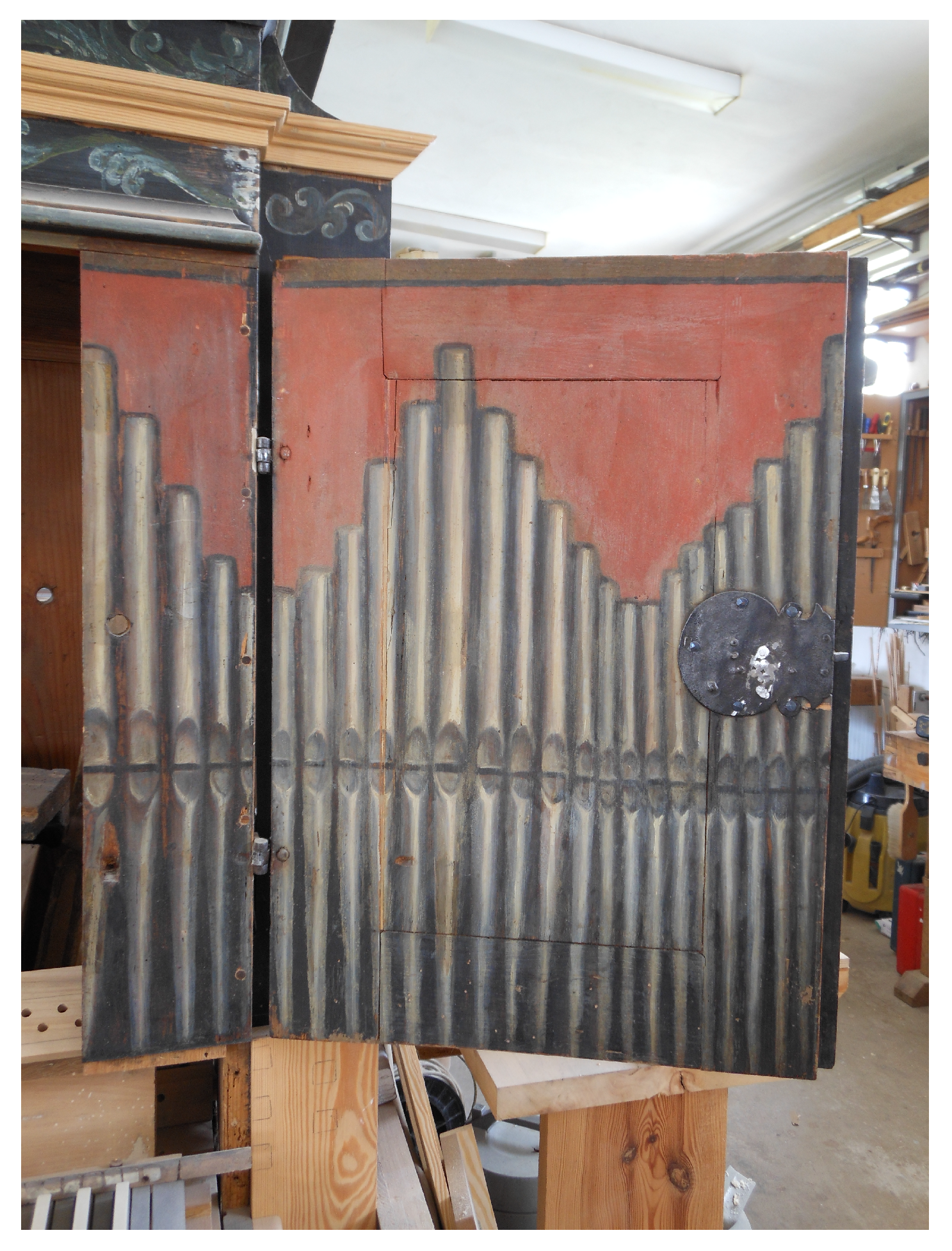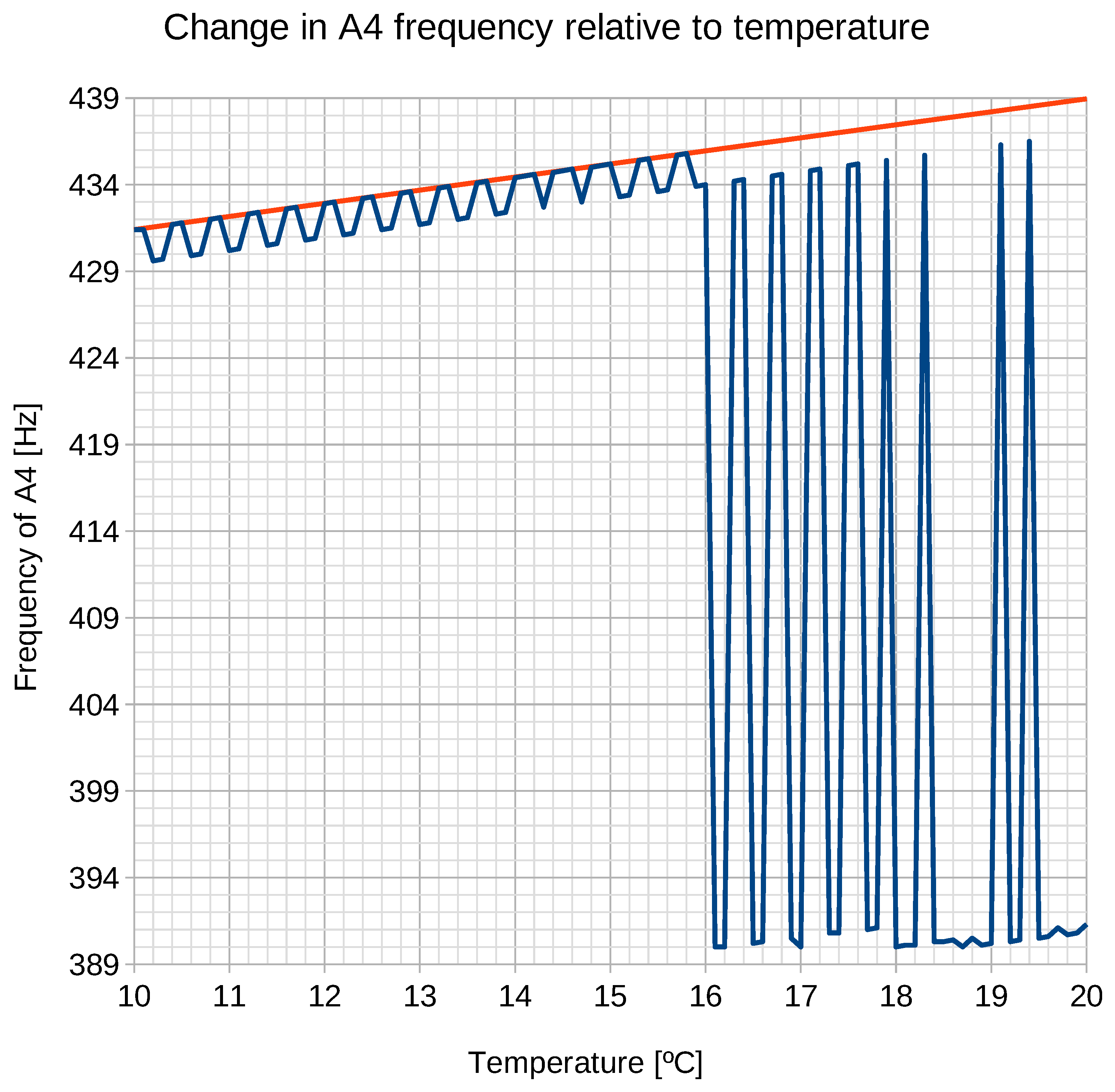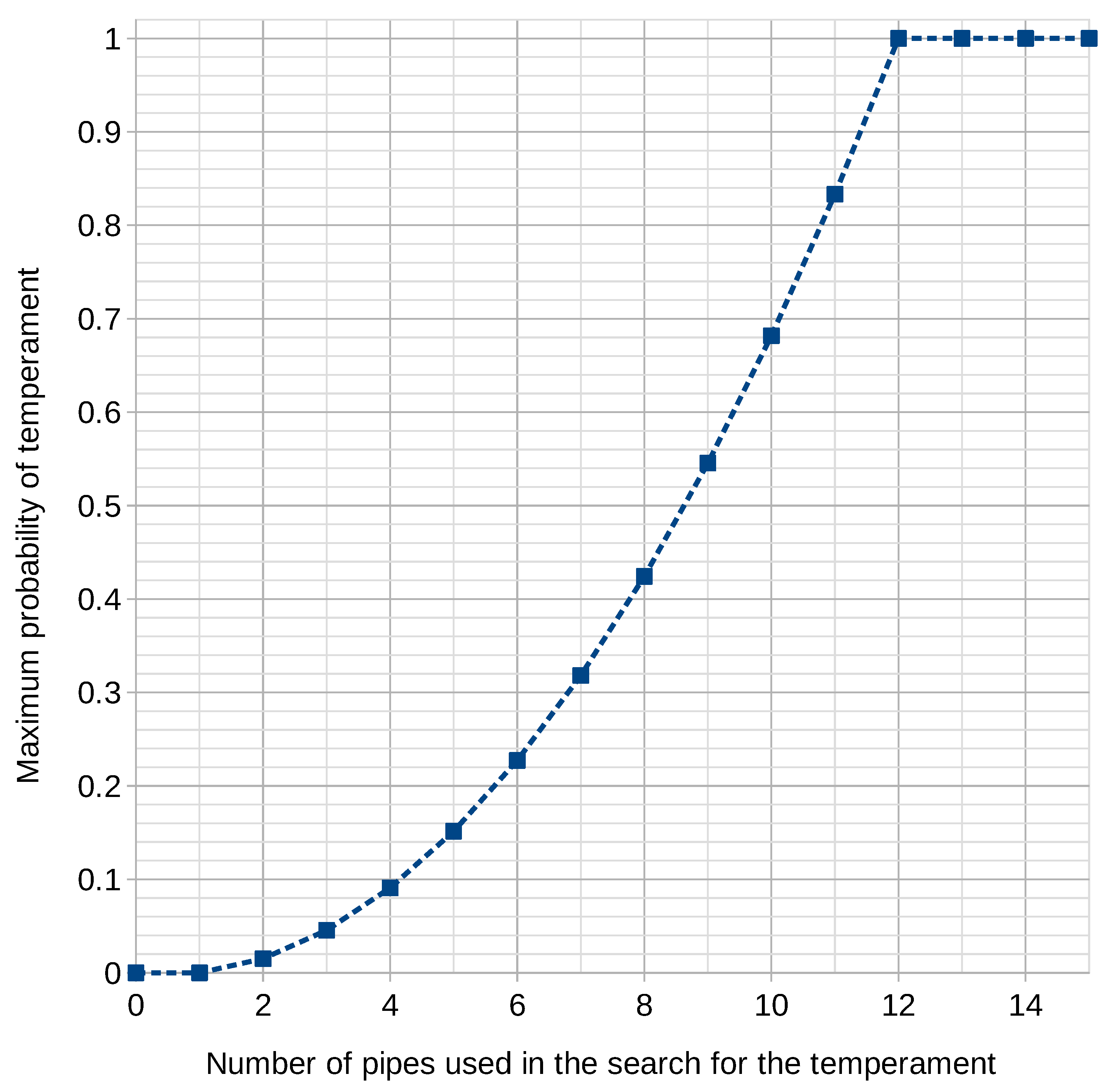Pattern Recognition in Music on the Example of Reconstruction of Chest Organ from Kamień Pomorski
Abstract
:1. Introduction
1.1. The Reconstructed Instrument
1.2. Description of the Instrument
2. Voicing and Tempering of a Pipe Organ
2.1. Sound Generation in Organ Pipes
2.2. The A4 Frequency in Historic Organs
2.3. Historic Temperaments
3. Finding the Pattern of Temperament—Method
3.1. Introduction
3.2. Set of Possible Temperaments
3.3. Input Set for Temperament Search
3.4. Probability of Temperament
3.5. Algorithm of Searching for the Most Probable Temperament
- 1.
- Create set ;
- 2.
- Create set ;
- 3.
- Specify the initial value of ;
- 4.
- Specify the step of interval uncertainty reduction ;
- 5.
- Compute set ;
- 6.
- Does contain at least two values of 1?;
- 7.
- If so, , then go back to 5;
- 8.
- For each temperament in , calculate the value of ;
- 9.
- Sort in descending order (in relation to values);
- 10.
- Return a well-ordered set from 9, and the ultimate value of .
3.6. Graphical Presentation of the Search Result
4. Method of Searching for A4 Reference Pitch—The Second Pattern
4.1. Defining the Frequency Boundaries of the Sound A4—Discussion
4.2. The Method of Searching for A4
- 1.
- Specify , the set of pipe lengths, and the temperament;
- 2.
- Create set for air temperature ;
- 3.
- Generate set for the specified temperament and frequencies from to , every ;
- 4.
- For each set within , calculate how many frequencies from each particular set are present in . Remember this value as , where f denotes the same frequency as in . The accuracy of the comparison is specified in advance by the interval determined by ;
- 5.
- Specify f for the highest as the frequency of the reference pitch A4.
4.3. Finding the Correct Temperature—The Third Pattern
5. Discussion
5.1. Introduction
5.2. Establishing the Minimum Number of Pipes
5.3. Correct Method of Establishing the Frequency of A4 Sound
5.4. Establishing the Tuning Temperature
6. Final Results
7. Conclusions
Funding
Institutional Review Board Statement
Informed Consent Statement
Data Availability Statement
Conflicts of Interest
References
- Owen, B. The Registration of Baroque Organ Music; Indiana University Press: Bloomington, IN, USA, 1997. [Google Scholar]
- Wolff, C.; Zepf, M. The Organs of J.S. Bach: A Handbook; University of Illinois Press: Champaign, IL, USA, 2011. [Google Scholar]
- Dobrovolnỳ, P.; Moberg, A.; Brázdil, R.; Pfister, C.; Glaser, R.; Wilson, R.; van Engelen, A.; Limanówka, D.; Kiss, A.; Halíčková, M.; et al. Monthly, seasonal and annual temperature reconstructions for Europe derived from documentary evidence and instrumental records since AD 1500. Clim. Chang. 2010, 101, 69–107. [Google Scholar] [CrossRef]
- Glaser, R.; Riemann, D. A thousand-year record of temperature variations for Germany and Central Europe based on documentary data. J. Quat. Sci. Publ. Quat. Res. Assoc. 2009, 24, 437–449. [Google Scholar] [CrossRef]
- Benson, D. Music: A Mathematical Offering; Cambridge University Press: Cambridge, UK, 2007. [Google Scholar]
- Fletcher, N.H.; Rossing, T.D. The Physics of Musical Instruments; Springer Science & Business Media: Cham, Switzerland, 2012. [Google Scholar]
- Helmholtz, H.V. Theorie der Luftschwingungen in Röhren mit offenen Enden. J. Reine Angew. Math. 1860, 57, 1–72. [Google Scholar]
- Helmholtz, H.V. On the Sensations of Tone as a Physiological Basis for the Theory of Music; Longmans, Green: London, UK, 1912. [Google Scholar]
- Rayleigh, J.W.S.B. The Theory of Sound; Macmillan: Basingstoke, UK, 1896; Volume 2. [Google Scholar]
- Anderson, S.H.; Ostensen, F.C. Effect of frequency on the end correction of pipes. Phys. Rev. 1928, 31, 267. [Google Scholar] [CrossRef]
- Jones, A.T. End corrections of organ pipes. J. Acoust. Soc. Am. 1941, 12, 387–394. [Google Scholar] [CrossRef]
- Audsley, G.A. The Art of Organ Building; Dodd, Mead and Company: New York, NY, USA, 1905. [Google Scholar]
- Finch, T.; Nolle, A. Pressure wave reflections in an organ note channel. J. Acoust. Soc. Am. 1986, 79, 1584–1591. [Google Scholar] [CrossRef]
- Nolle, A.; Finch, T. Starting transients of flue organ pipes in relation to pressure rise time. J. Acoust. Soc. Am. 1992, 91, 2190–2202. [Google Scholar] [CrossRef]
- Verge, M.P.; Fabre, B.; Mahu, W.E.A.; Hirschberg, A.; Van Hassel, R.R.; Wijnands, A.P.J.; De Vries, J.J.; Hogendoorn, C.J. Jet formation and jet velocity fluctuations in a flue organ pipe. J. Acoust. Soc. Am. 1994, 95, 1119–1132. [Google Scholar] [CrossRef] [Green Version]
- Yoshikawa, S. Jet-wave amplification in organ pipes. J. Acoust. Soc. Am. 1998, 103, 2706–2717. [Google Scholar] [CrossRef]
- Kokkelmans, S.J.; Verge, M.P.; Hirschberg, A.; Wijnands, A.; Schoffelen, R. Acoustic behavior of chimney pipes. J. Acoust. Soc. Am. 1999, 105, 546–551. [Google Scholar] [CrossRef]
- Rioux, V. Sound Quality of Flue Organ Pipe. An Interdisciplinary Study on the Art of Voicing; Chalmers University of Technology: Gothenburg, Sweden, 2001. [Google Scholar]
- De Lauro, E.; De Martino, S.; Esposito, E.; Falanga, M.; Primo Tomasini, E. Analogical model for mechanical vibrations in flue organ pipes inferred by independent component analysis. J. Acoust. Soc. Am. 2007, 122, 2413–2424. [Google Scholar] [CrossRef]
- Außerlechner, H.J.; Trommer, T.; Angster, J.; Miklós, A. Experimental jet velocity and edge tone investigations on a foot model of an organ pipe. J. Acoust. Soc. Am. 2009, 126, 878–886. [Google Scholar] [CrossRef]
- Trommer, T.; Angster, J.; Miklós, A. Roughness of organ pipe sound due to frequency comb. J. Acoust. Soc. Am. 2012, 131, 739–748. [Google Scholar] [CrossRef] [PubMed]
- Rucz, P.; Trommer, T.; Angster, J.; Miklós, A.; Augusztinovicz, F. Sound design of chimney pipes by optimization of their resonators. J. Acoust. Soc. Am. 2013, 133, 529–537. [Google Scholar] [CrossRef] [PubMed]
- Vaik, I.; Paál, G. Flow simulations on an organ pipe foot model. J. Acoust. Soc. Am. 2013, 133, 1102–1110. [Google Scholar] [CrossRef] [PubMed]
- Rucz, P.; Augusztinovicz, F.; Angster, J.; Preukschat, T.; Miklós, A. Acoustic behavior of tuning slots of labial organ pipes. J. Acoust. Soc. Am. 2014, 135, 3056–3065. [Google Scholar] [CrossRef] [PubMed]
- Mickiewicz, W. Particle Image Velocimetry and Proper Orthogonal Decomposition Applied to Aerodynamic Sound Source Region Visualization in Organ Flue Pipe. Arch. Acoust. 2015, 40, 475–484. [Google Scholar] [CrossRef]
- Rucz, P.; Augusztinovicz, F.; Angster, J.; Preukschat, T.; Miklós, A. A finite element model of the tuning slot of labial organ pipes. J. Acoust. Soc. Am. 2015, 137, 1226–1237. [Google Scholar] [CrossRef] [PubMed]
- Hruška, V.; Dlask, P. Investigation of the Sound Source Regions in Open and Closed Organ Pipes. Arch. Acoust. 2019, 44, 467–474. [Google Scholar]
- Czyżewski, A.; Kostek, B.; Zieliński, S. Synthesis of organ pipe sound based on simplified physical models. Arch. Acoust. 1996, 21, 131–147. [Google Scholar]
- Węgrzyn, D.; Wrzeciono, P. Problem of placing the organ pipes on the windchest. Vib. Phys. Syst. 2019, 30, 2019121. [Google Scholar]
- Hruška, V.; Dlask, P. On a Robust Descriptor of the Flue Organ Pipe Transient. Arch. Acoust. 2020, 45, 377–384. [Google Scholar]
- Ginsberg, J.H. Acoustics—A Textbook for Engineers and Physicists: Volume I: Fundamentals; Springer: Cham, Switzerland, 2017. [Google Scholar]
- ISO 16:1975 Acoustics—Standard Tuning Frequency (Standard Musical Pitch); Standard; International Organization for Standardization: Geneva, Switzerland, 1975.
- Barbour, J.M. Tuning and Temperament: A Historical Survey; Courier Corporation: Chelmsford, MA, USA, 2004. [Google Scholar]
- Pantalony, D. Altered Sensations: Rudolph Koenig’s Acoustical Workshop in Nineteenth-Century Paris; Springer Science & Business Media: Cham, Switzerland, 2009; Volume 24. [Google Scholar]
- Lang, K. Auf Wohlklangswellen durch der Töne Meer: Temperaturen und Stimmungen Zwischen dem 11. und 19. Jahrhundert; Institut für Elektronische Musik (IEM) an der Universität für Musik und Darstellende Kunst: Graz, Austria, 1999. [Google Scholar]
- Gołos, J.; Smulikowska, E. The Polish Organ: The Instrument and Its History; Sutkowski Edition: Warsaw, Poland, 1993; Volume 1. [Google Scholar]
- Gołos, J.; Smulikowska, E. The Polish Organ: Organ-Cases in Poland as Works of Art; Sutkowski Edition: Warsaw, Poland, 1993; Volume 2. [Google Scholar]
- Middleton, W.E.K. A History of the Thermometer and Its Use in Meteorology; Johns Hopkins Univ Pr: Baltimore, MD, USA, 1966. [Google Scholar]
- Babst, F.; Poulter, B.; Trouet, V.; Tan, K.; Neuwirth, B.; Wilson, R.; Carrer, M.; Grabner, M.; Tegel, W.; Levanic, T.; et al. Site-and species-specific responses of forest growth to climate across the European continent. Glob. Ecol. Biogeogr. 2013, 22, 706–717. [Google Scholar] [CrossRef]
- Kypetová, M.; Walas, Ł.; Jaloviar, P.; Iszkuło, G. Influence of herbivory pressure on the growth rate and needle morphology of Taxus baccata L. juveniles. Dendrobiology 2018, 79, 10–19. [Google Scholar] [CrossRef] [Green Version]
- Bishop, J. In the wind. Diapason 2016, 107, 16–17. [Google Scholar]
- Barbour, J.M. Musical Logarithms. Scr. Math. 1940, 7, 21–37. [Google Scholar]
- Forbes, R.J.; Fokker, A.; Romein-Verschoor, A. The Principal Works of Simon Stevin; Engineering. Music. Civic Life; Swets & Zeitlinger: Amsterdam, The Netherlands, 1966; Volume 5. [Google Scholar]
- White, W.B. Modern Piano Tuning and Allied Arts; Edward Lyman Bill: New York, NY, USA, 1917. [Google Scholar]
- Martin, D.W.; Ward, W. Subjective evaluation of musical scale temperament in pianos. J. Acoust. Soc. Am. 1961, 33, 582–585. [Google Scholar] [CrossRef]
- Campbell, M.; Greated, C.A.; Myers, A. Musical Instruments: History, Technology, and Performance of Instruments of Western Music; Oxford University Press: Oxford, UK, 2004. [Google Scholar]
- Jorgensen, O.H. Tuning: Containing the Perfection of Eighteenth-Century Temperament, the Lost Art of Nineteenth-Century Temperament, and the Science of Equal Temperament, Complete with Instructions for Aural and Electronic Tuning; Michigan State University Press East Lansing: East Lansing, MI, USA, 1991. [Google Scholar]
- Duffin, R.W. How Equal Temperament Ruined Harmony (and Why You Should Care); WW Norton & Company: New York, NY, USA, 2007. [Google Scholar]
- Harnoncourt, N. Baroque Music Today: Music as Speech: Ways to a New Understanding of Music; Amadeus Press: Cleckheaton, UK, 1991. [Google Scholar]
- Aaron, P. Toscanello in Musica (Classical Reprint) 1523; Forgotten Books: London, UK, 2018. [Google Scholar]
- Lehman, B. Bach’s Extraordinary Temperament: Our Rosetta Stone: 1. Early Music 2005, 33, 3–23. [Google Scholar] [CrossRef]
- Lehman, B. Bach’s Extraordinary Temperament: Our Rosetta Stone: 2. Early Music 2005, 33, 211–231. [Google Scholar] [CrossRef]
- Sandage, M.J.; Connor, N.P.; Pascoe, D.D. Vocal function and upper airway thermoregulation in five different environmental conditions. J. Speech Lang. Hear. Res. 2014, 57, 16–25. [Google Scholar] [CrossRef]
- Devore, J.L. Probability and Statistics for Engineering and the Sciences; Cengage Learning: Boston, MA, USA, 2011. [Google Scholar]






| Left Wing | Right Wing (Numbering Continued) | ||
|---|---|---|---|
| Pipe Number, from Left to Right (Figure 1 and Figure 3) | Air Column Length [cm] | Pipe Number, from Left to Right (Figure 1 and Figure 4) | Air Column Length [cm] |
| 1 | 34.850 | 26 | 32.250 |
| 2 | 28.615 | 27 | 27.225 |
| 3 | 24.515 | 28 | 21.830 |
| 4 | 21.620 | 29 | 16.615 |
| 5 | 18.975 | 30 | 13.990 |
| 6 | 18.040 | 31 | 14.240 |
| 7 | 17.900 | 32 | 15.995 |
| 8 | 17.730 | 33 | 19.055 |
| 9 | 19.445 | 34 | 24.240 |
| 10 | 21.850 | 35 | 28.680 |
| 11 | 24.520 | 36 | 33.016 |
| 12 | 29.200 | 37 | 28.030 |
| 13 | 34.190 | 38 | 24.640 |
| 14 | 29.400 | 39 | 21.240 |
| 15 | 24.510 | 40 | 17.900 |
| 16 | 19.750 | 41 | 15.580 |
| 17 | 14.500 | 42 | 14.155 |
| 18 | 13.350 | 43 | 14.070 |
| 19 | 13.145 | 44 | 13.905 |
| 20 | 13.645 | 45 | 18.425 |
| 21 | 14.645 | 46 | 20.400 |
| 22 | 19.715 | 47 | 21.630 |
| 23 | 23.510 | 48 | 24.930 |
| 24 | 27.905 | 49 | 27.705 |
| 25 | 32.410 | 50 | 33.725 |
| Type of | Intervals [Cents] | |||||||||||
|---|---|---|---|---|---|---|---|---|---|---|---|---|
| Temperament | A–A | A–A# | A–B | A–C | A–C# | A–D | A–D# | A–E | A–F | A–F# | A–G | A–G# |
| Equal | 0.00 | 100.00 | 200.00 | 300.00 | 400.00 | 500.00 | 600.00 | 700.00 | 800.00 | 900.00 | 1000.00 | 1100.00 |
| Pythagorean | 0.00 | 90.23 | 189.18 | 294.14 | 393.09 | 498.05 | 597.00 | 701.95 | 792.18 | 891.14 | 996.09 | 1095.05 |
| Pietro Aaron | 0.00 | 117.00 | 193.00 | 310.00 | 386.00 | 503.00 | 620.00 | 696.00 | 813.00 | 889.00 | 1007.00 | 1083.00 |
| Tuner’s guide well #3 | 0.00 | 100.99 | 199.09 | 300.35 | 398.71 | 500.21 | 601.07 | 699.07 | 800.21 | 898.47 | 999.88 | 1100.65 |
| A | A# | B | C | C# | D | D# | E | F | F# | G | G# | |
| A | 0 | 5 | 3 | 2 | 3 | 3 | 2 | 3 | 3 | 2 | 3 | 5 |
| A# | 5 | 0 | 3 | 3 | 1 | 3 | 3 | 2 | 3 | 2 | 2 | 2 |
| B | 3 | 3 | 0 | 5 | 3 | 2 | 2 | 3 | 2 | 3 | 3 | 2 |
| C | 2 | 3 | 5 | 0 | 3 | 3 | 2 | 3 | 3 | 2 | 3 | 2 |
| C# | 3 | 1 | 3 | 3 | 0 | 5 | 2 | 2 | 2 | 3 | 2 | 3 |
| D | 3 | 3 | 2 | 3 | 5 | 0 | 5 | 3 | 2 | 3 | 3 | 2 |
| D# | 2 | 3 | 2 | 2 | 2 | 5 | 0 | 3 | 3 | 1 | 3 | 0 |
| E | 3 | 2 | 3 | 3 | 2 | 3 | 3 | 0 | 5 | 3 | 2 | 3 |
| F | 3 | 3 | 2 | 3 | 2 | 2 | 3 | 5 | 0 | 3 | 3 | 1 |
| F# | 2 | 2 | 3 | 2 | 3 | 3 | 1 | 3 | 3 | 0 | 5 | 3 |
| G | 3 | 2 | 3 | 3 | 2 | 3 | 3 | 2 | 3 | 5 | 0 | 3 |
| G# | 5 | 2 | 2 | 2 | 3 | 2 | 0 | 3 | 1 | 3 | 3 | 0 |
| Frequency | 392 Hz | 415 Hz | 435 Hz | 440 Hz | 466 Hz |
|---|---|---|---|---|---|
| Musical sound | G4 | G#4 | A4 | A4 | A#4 |
| Temperament | Meantone, 1/4–Comma, Published by Pietro Aaron | |
|---|---|---|
| Temperament probability: | 0.985 | |
| Frequency of A4: | 435.2 Hz | 435.8 Hz |
| Tuning temperature of the instrument: | 15.0 C | 15.8 C |
| Note | C4 | C#4 | D4 | D#4 | E4 | F4 |
|---|---|---|---|---|---|---|
| Hz | 260.31 | 272.00 | 291.04 | 311.40 | 325.39 | 348.16 |
| Note | F#4 | G4 | G#4 | A4 | A#4 | B4 |
| Hz | 363.80 | 389.25 | 406.74 | 435.20 | 465.66 | 486.57 |
| Order | Temperament | Probability | Value of | A4 frequency [Hz] for 15 C |
|---|---|---|---|---|
| 1 | Pietro Aaron quarter syntonic (1523) | 0.985 | 364 | 435.2 |
| 2 | Charles Earl Stanhope (1806) | 0.864 | 356 | 433.3 |
| 3 | John Holden 1/5 syntonic (1770) | 1.000 | 354 | 434.0 |
| 4 | Marin Mersenne & Lambert Chaumont (1636) | 0.955 | 354 | 433.2 |
| 5 | Improved William Hawkes meantone (1798) | 0.970 | 348 | 434.0 |
| 6 | 1797 meantone | 0.970 | 344 | 434.0 |
| 7 | 1799 meantone | 0.970 | 344 | 434.0 |
| 8 | William Hawkes meantone (1798) | 0.985 | 342 | 434.0 |
| 9 | Johann Philipp Kirnberger “well” (1801) | 0.970 | 340 | 435.3 |
| 10 | A. Merrick quite equal (1811) | 0.955 | 334 | 431.8 |
Publisher’s Note: MDPI stays neutral with regard to jurisdictional claims in published maps and institutional affiliations. |
© 2021 by the author. Licensee MDPI, Basel, Switzerland. This article is an open access article distributed under the terms and conditions of the Creative Commons Attribution (CC BY) license (https://creativecommons.org/licenses/by/4.0/).
Share and Cite
Wrzeciono, P. Pattern Recognition in Music on the Example of Reconstruction of Chest Organ from Kamień Pomorski. Sensors 2021, 21, 4163. https://doi.org/10.3390/s21124163
Wrzeciono P. Pattern Recognition in Music on the Example of Reconstruction of Chest Organ from Kamień Pomorski. Sensors. 2021; 21(12):4163. https://doi.org/10.3390/s21124163
Chicago/Turabian StyleWrzeciono, Piotr. 2021. "Pattern Recognition in Music on the Example of Reconstruction of Chest Organ from Kamień Pomorski" Sensors 21, no. 12: 4163. https://doi.org/10.3390/s21124163






